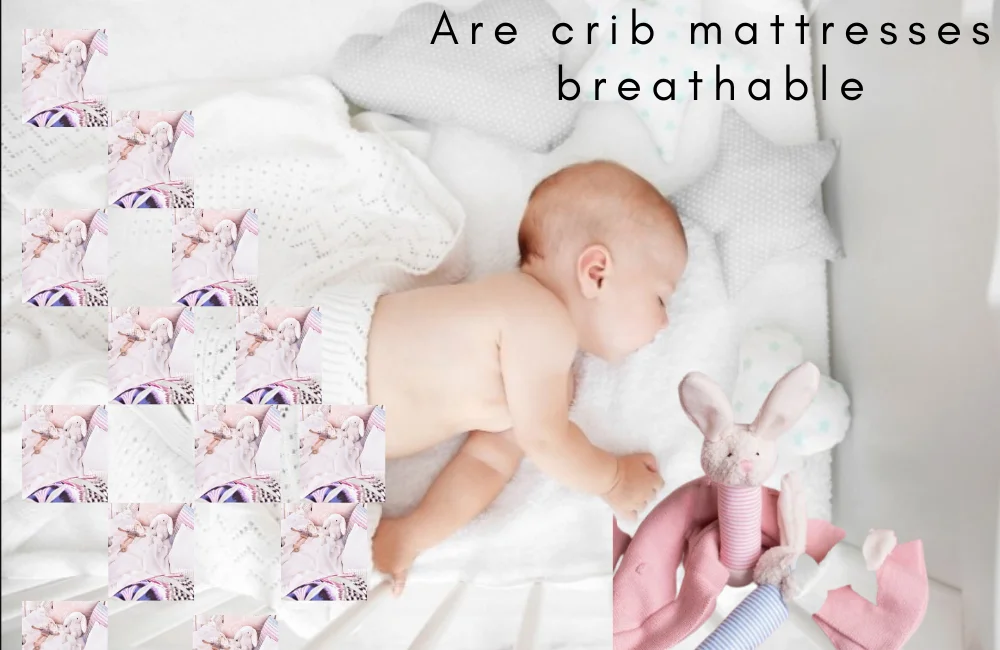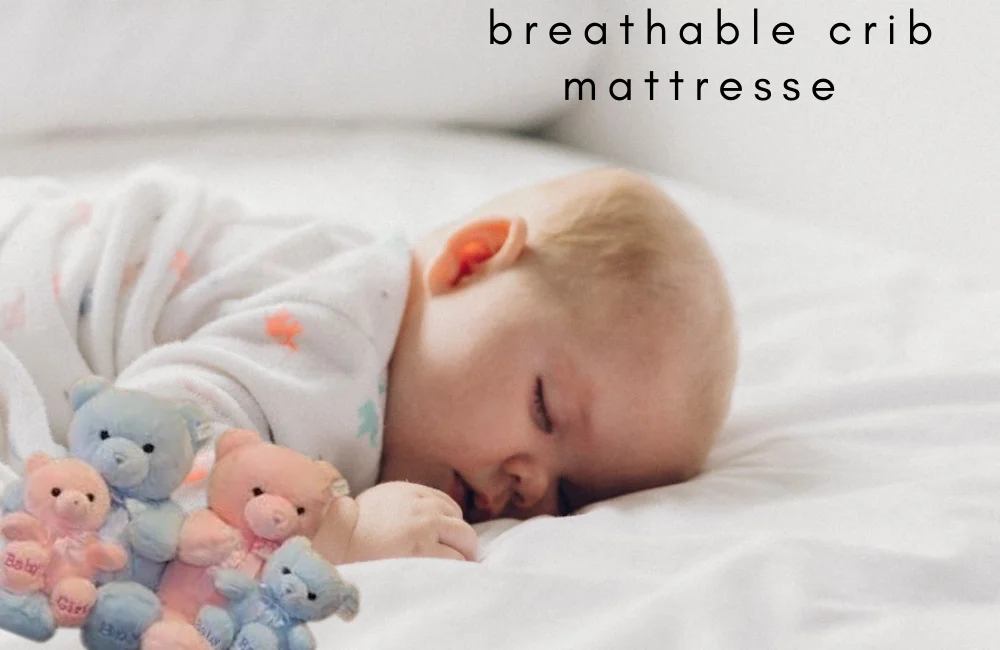As a parent, I know that sleep is a precious commodity. Both for the baby and for me! One of the questions that often keeps me up at night is: Are crib mattresses breathable?
I mean, babies look cute when they’re asleep, but the last thing I want is to worry about their safety while they dream.
Let’s dive into the world of crib mattresses and uncover what “breathable” really means. Spoiler alert: it’s not about the mattress having a stuffy nose!

What Are Breathable Mattresses?
Breathable mattresses are designed to allow air to circulate. This keeps the surface dry and cool. Usually, they are made with a design that maximizes airflow, which is accomplished by using particular building materials or methods.
A typical feature is a mesh cover that provides support while letting air flow through. Additionally, certain mattresses have ventilation holes.
They are positioned carefully to improve airflow. Another important consideration is the core material. Natural materials like cotton or wool are used in some mattresses.
Others employ foam that has been particularly created to improve airflow. The primary goals are to improve comfort and lessen overheating.
Babies benefit greatly from breathable mattresses in particular. SIDS (Sudden Infant Death Syndrome) is associated with overheating.
It is possible to help a baby stay warm by using a mattress that allows for ventilation. It’s also simpler for me to clean these mattresses. Many mattresses feature removable covers, which makes it easier to keep the mattress fresh and clean.
Finally, breathable mattresses improve ventilation, control temperature, and frequently have a cover that is machine washable. You or your infant can sleep soundly and peacefully with them, giving you peace of mind.
Are Crib Mattresses Breathable?
Ensuring a safe and comfortable sleeping environment for our little ones is a top priority for parents. From selecting the right crib to choosing bedding materials, every decision matters.
Among these considerations is the breathability of crib mattresses. In this article, we’ll delve into the essential aspects of crib mattress breathability and its implications for baby sleep safety.

Understanding Crib Mattress Breathability
When it comes to crib mattresses, one crucial factor to consider is breathability. But what exactly makes a mattress breathable?
In simple terms, a breathable mattress is one that allows air to flow through its surface, ensuring adequate ventilation for the baby.
This feature becomes particularly important as babies grow and become more mobile during sleep.
Breathable vs. Non-Breathable Mattresses
Not all crib mattresses are created equal in terms of breathability. Organic mattresses, typically made with porous materials, offer excellent breathability.
On the other hand, non-organic or waterproof mattresses often feature plastic surfaces that restrict airflow.
While both types have their pros and cons, the choice between breathable and non-breathable mattresses ultimately depends on individual preferences and needs.
Safety Considerations
Parents may wonder whether babies can breathe properly on non-breathable mattresses. The answer lies in proper bedding practices.
Regardless of the mattress type, ensuring a snugly fitted cotton sheet is crucial. This not only enhances comfort but also promotes airflow around the baby’s sleeping area, reducing the risk of suffocation.
Addressing Concerns
Sudden Infant Death Syndrome (SIDS) is a concern for many parents, but it’s essential to note that mattress breathability alone does not eliminate this risk.
By following safe sleep guidelines, such as avoiding loose bedding and placing babies on their backs to sleep, parents can significantly reduce the likelihood of SIDS, regardless of the mattress type.
Identifying Breathable Mattresses
Organic mattresses are often touted for their breathability and safety. When shopping for a crib mattress, look for organic options made from natural, breathable materials.
Additionally, check product labels for information on materials used and manufacturing practices to make an informed decision.
Sleep Position Recommendations
While placing babies on their backs for sleep is recommended, parents may wonder about stomach sleeping on breathable mattresses.
While back sleeping is safest, if a baby rolls onto their stomach, there’s generally no cause for alarm as long as the sleeping surface is safe and free of hazards.
You May Also Like: What Are The Measurements Of A Crib Mattress?
When Is The Appropriate Time For Babies To Sleep On Their Stomachs?
The appropriate time for babies to sleep on their stomachs is once they can roll over on their own. This usually happens around 6 months of age.
But it is better to place babies on their backs for as long as 12 months from birth. I always make sure to put babies to sleep on their backs. This reduces the risk of SIDS.
Once a baby can roll both ways, stomach sleeping is generally safe. However, I still place them on their back initially.
If they roll over during sleep, I don’t need to move them back. It’s a sign they have enough strength and mobility.
I always ensure the sleep environment is safe. I avoid loose bedding and soft toys in the crib. This minimizes any suffocation risks.
In summary, babies can safely sleep on their stomachs once they can roll over on their own. Always start with back sleeping and maintain a safe sleep environment.
What Are The Chances Of Suffocation With A Non-Breathable Mattress?
As a sleep expert, I often get asked about the chances of suffocation with a non-breathable mattress. The risks are real and significant,
especially for infants and toddlers. A non-breathable mattress restricts airflow, which can lead to suffocation.
Infants are particularly vulnerable because they might not have the ability to reposition themselves if they are face-down on the mattress.
This increases the risk of Sudden Infant Death Syndrome (SIDS). For adults, the risk is lower but still present, particularly if you sleep on your stomach.
I always recommend breathable mattresses for safety. These mattresses allow for better air circulation, reducing the risk of suffocation. They are designed to keep air flowing even if the sleeper is face-down.
Another tip is to avoid adding extra layers like thick mattress pads or toppers that can restrict airflow.
When choosing a mattress, always prioritize safety features. Look for materials that promote breathability and are certified safe.
Finally, the chances of suffocation with a non-breathable mattress are too high to ignore. It’s crucial to invest in a breathable, safe mattress for peace of mind and better sleep health. Always check the specifications and safety standards of the mattress before purchasing.
FAQs
What does a breathable crib mattress mean?
It allows air to circulate through the mattress. This reduces the risk of suffocation.
Why is breathability important for a crib mattress?
Breathable mattresses help prevent overheating. They also promote better airflow for baby safety.
Are all crib mattresses breathable?
No, not all crib mattresses are designed to be breathable. It’s important to check the product specifications.
How can I tell if a crib mattress is breathable?
Look for materials like mesh or other ventilated designs. Read product descriptions and reviews for details.
Do breathable mattresses reduce the risk of SIDS?
They may help lower the risk of SIDS by improving airflow. However, no mattress can completely prevent SIDS.
Are breathable crib mattresses more expensive?
They can be more expensive than non-breathable ones. Prices vary depending on the brand and features.
Can I use a mattress protector with a breathable crib mattress?
Yes, you can use a mattress protector. Make sure it is also breathable to maintain airflow.
How do I clean a breathable crib mattress?
Follow the manufacturer’s cleaning instructions. Many have removable, washable covers for easy cleaning.
Do breathable crib mattresses last as long as regular ones?
Yes, they are designed to be durable and long-lasting. Proper care will help maintain their quality.
Is a breathable crib mattress hypoallergenic?
Many breathable mattresses are hypoallergenic. Always check the product details to confirm.
Final Thoughts
In conclusion, crib mattress breathability is an important consideration for baby sleep safety. While organic mattresses are often preferred for their breathability,
proper bedding practices and adherence to safe sleep guidelines are paramount, regardless of the mattress type.
By prioritizing safety and comfort, parents can create a secure sleeping environment for their little ones, ensuring peaceful nights for the entire family.
